Best Yoga Mats in India – Top 7 Brands

Table of Contents
Searching for the best yoga mat in India can be as calming as the practice itself, especially when you know what you’re looking for. Whether you’re a seasoned yogi or just starting out, the right mat can transform your practice, offering the support and comfort you need.
In a market brimming with options, eco-conscious consumers are turning to brands like Almitra Sustainables and Cork Yoga, known for their durable, high-quality mats. These brands stand out for their commitment to sustainability, ensuring that your yoga practice aligns with your environmental values.
On Earth mats further elevate your yoga experience with their premium, eco-friendly designs. Choosing the perfect mat isn’t just about the cushioning or price—it’s about the harmony between your practice and the planet. So, let’s roll out the mat on your quest for the best yoga companion in India.
List of 8 Best Yoga Mats in India
Selecting the right yoga mat can dramatically improve your practice. Let’s delve into the details of eight sought-after yoga mats that cater to various preferences, from eco-friendliness to enhanced grip and comfort.
Solara Premium Yoga Mat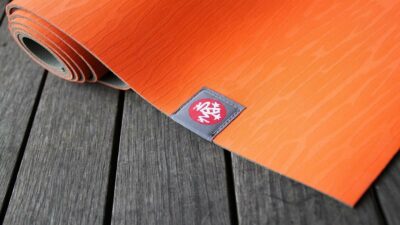
With the Solara Premium Yoga Mat, expect top-notch resilience and stability. Its 6mm thickness offers ample cushioning, ensuring you can strike poses with confidence. Its 1kg weight makes it a solid choice for those prioritising a blend of comfort and durability. Trust this mat to support your most challenging flows.
Fitness Mantra Yoga Mat

The Fitness Mantra Yoga Mat is acclaimed for its durable EVA material, providing excellent slip resistance and injury prevention. It ensures a secure grip and supports your body’s natural alignment during workouts. Built to last, Fitness Mantra delivers a reliable mat, regardless of the intensity of your exercise routine.
Symactive Yoga Mat
Choose the Symactive Yoga Mat to bring a professional edge to your practice. It’s designed for those who need a reliable surface that supports dynamic workouts. The material’s grip improves with each use, adapting to your personal yoga journey.
AmazonBasics Yoga Mat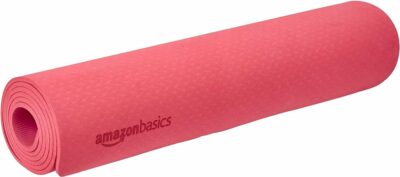
AmazonBasics Yoga Mat stands out with its extra-thick NBR foam, which is perfect for those requiring additional joint protection. At 13mm thick and 997g in weight, this mat is a testament to combining plush comfort with practical transportation.
Dr. Trust TPE Premium Yoga Mat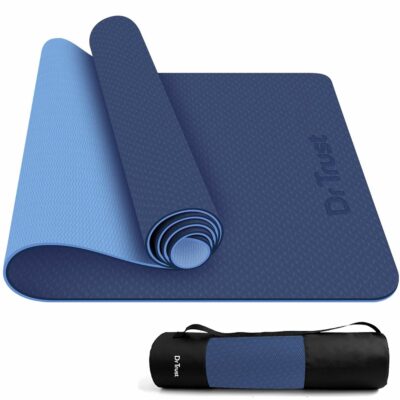
Lean on the Dr. Trust TPE Premium Yoga Mat for an eco-conscious choice. Its 6mm thickness balances softness and firm support, and the sustainable materials make it an excellent choice for those looking to minimize their carbon footprint while optimizing their practice.
Boldfit Yoga Mat

The Boldfit Yoga Mat, available in both 5mm and 6mm thicknesses, provides versatility for various yoga styles. The mat’s substantial weight of 900g to 1kg underscores its quality construction and the sustained comfort it offers throughout rigorous sessions.
WiseLife TruAlign Yoga Mat
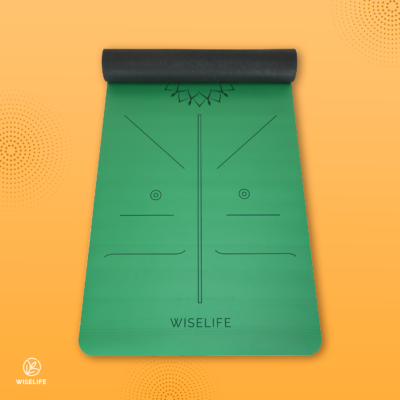
Focus on precision with the WiseLife TruAlign Yoga Mat. With alignment guides etched onto the surface, it’s a fantastic tool for honing your posture and technique. Ideal for beginners and experienced yogis alike, this mat is essential for those refining their practice.
Fashnex TPE Yoga Mat
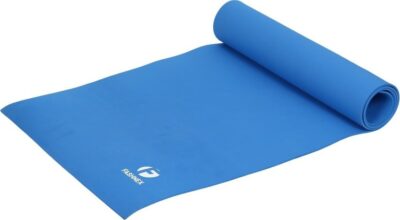
The Fashnex TPE Yoga Mat is built for the eco-aware yogi. This mat boasts a biodegradable composition and provides excellent traction and resilience. It’s suited for anyone seeking an alignment between their fitness endeavours and environmental consciousness.
Factors to consider when buying a yoga mat
Selecting the right yoga mat can significantly enhance your practice, ensuring comfort and stability. While the variety of choices might seem overwhelming, focusing on a few key aspects can guide you to the perfect mat for your needs. Here are some essential factors to consider.
Durability
Your yoga mat’s longevity is a primary consideration. Invest in a mat that withstands regular practice and the wear and tear of your yoga style. For instance, if you often perform dynamic sequences like Vinyasa or Power Yoga, a mat that resists compression and maintains its shape over time is crucial. The durability of a yoga mat is generally reflected in its warranty; a longer warranty can be an indication of a mat’s resilience.
Additionally, eco-friendly materials such as Thermoplastic Elastomers (TPE) are not only sustainable but also known for their durability. TPE mats often strike a balance between being lightweight for mobility and robust enough for daily use. The quality of the mat’s construction can also contribute to its lifespan, with tightly-woven or dense materials offering more resistance to punctures or tears.
Material
The material of your yoga mat has a direct impact on its grip, texture, and how it feels beneath your hands and feet. Options range from PVC, which offers significant stickiness and durability, to eco-conscious choices like TPE and natural rubber.
When considering the material, also ponder over its ecological footprint. You’d want to go for Non-Toxic and Eco-Friendly options, especially if you are environmentally conscious. TPE, for example, is a popular choice as it’s free from PVC and often recyclable.
Moreover, the texture of the material affects your mat’s slip resistance. A higher grip can prevent injuries and allow you to hold poses with more confidence. Look for features such as a Diamond-Cut Texture or other patternings that can increase traction, especially when you sweat.
Thickness
The mat’s thickness is integral to your comfort, particularly if you have sensitive joints or practice on hard surfaces. Standard mats typically range from 3mm to 6mm, providing a middle ground between cushioning and stability.
A thicker mat, around 13mm, offers enhanced cushioning and is ideal for restorative sessions, Pilates, or any practice that requires being on the floor for extended periods. However, while thicker mats can be gentle on the joints, they might lack the firm stability needed for balancing poses.
Conversely, a thin mat, around 4mm, can offer a solid connection to the ground, which is beneficial for practices that involve standing and balance. Thin mats are also easier to roll up and carry, making them suitable for yogis on the go. Remember to find the balance between support and portability to fit your practice and lifestyle.
Comparison of the top yoga mats
Price
When you’re comparing yoga mats, price often reflects quality and features. However, you’ll find options catering to all budgets. High-end mats like The WiseLife TRU Alignment Yoga Mat come with a price tag reflecting their advanced specifications, like ProBalance technology and the inclusion of a premium mat bag. Alternatively, brands like Amazon Basics offer budget-friendly picks such as their 13mm Extra Thick NBR Yoga and Exercise Mat, ensuring affordability does not compromise necessary features like a textured surface for traction.
| Mat Type | Price (MRP) | Discount Offered |
|---|---|---|
| High-End Premium Mat | ₹ 2,379 | – |
| Budget-Friendly Option | ₹ 699 | 160 off |
| Mid-Range Quality Mat | ₹ 1,649 | 34% Off |
| Eco-Friendly Choice | ₹ 2,999 | – |
Size
Size matters when selecting a yoga mat. An extra-long mat like the TEGO CORE Yoga Mat, for example, measures 72×26 inches, offering more room for practising poses comfortably. In contrast, a typical mat might be around 68×24 inches. Ensure to choose a size that accommodates your height and the range of movements you anticipate in your yoga sessions. Adequate space is crucial for maintaining good form and ensuring safety during practice.
- Standard Size: Approximately 68×24 inches
- Extra Long: Typically around 72×26 inches
- Wide Options: Available for broader coverage
Grip
The grip is a non-negotiable feature for safety and performance. Mats like the Bodylastics Yoga Mat offer a double-sided sticky texture, crucial for maintaining poses without slipping. Innovative designs, such as honeycomb texture and closed-cell construction, can enhance the non-slip quality of the mat. Remember, a good grip ensures stability and can greatly aid in achieving correct posture during various asanas.
- Double-Sided Grip: Ensures traction on both sides
- Innovative Textures: Created for better adherence to the surface
- Closed-Cell Construction: Repels moisture and prevents slipping
The choice of your yoga mat can greatly affect your practice, so it pays to consider these factors during the comparison process. With the right balance of price, size, and grip, you’ll find a mat that perfectly suits your needs for comfort, safety, and longevity in your yoga journey.
Conclusion
Choosing the perfect yoga mat is a personal journey that mirrors your dedication to the practice. You’ve learned that not all mats are created equal and that the right one can enhance your yoga experience. With the insights on price, type, size, and grip, you’re now equipped to make an informed decision that aligns with your needs and budget. Remember that a mat that offers the right balance of comfort and stability will support your practice for years to come. So take your time, weigh your options, and select a mat that will be your ally on the mat, helping you to flow with confidence and ease.
Frequently Asked Questions
What yoga mat do celebrities use?
Celebrities often opt for premium brands like Manduka, which are favoured for their quality and durability. Stars such as Kate Hudson and Jessica Biel are known to use Manduka mats.
Which brand of yoga mat is best?
The best yoga mat brand can vary based on personal preference, but popular ones include Dr. Trust, Solara, and Fashnex TPE. Ratings and thickness vary from one brand to another, so choose according to your comfort and requirements.
Is a 4mm yoga mat okay?
Yes, a 4mm-5mm thickness is standard and provides a balance of cushioning and stability. However, if you need extra support for your joints, consider a slightly thicker mat around 6mm.
When should I replace my yoga mat?
Replace your yoga mat if you notice wear and tear, an unpleasant odour, if your joints hurt during practice, if the surface becomes uneven, if you switch yoga types, or if you sweat excessively and it affects the mat’s grip.
Why are yoga mats expensive?
Yoga mats can be expensive due to the use of high-quality, eco-friendly materials that ensure longevity and safety. They also often feature superior grip, which helps prevent injuries during practice.





